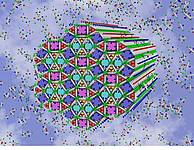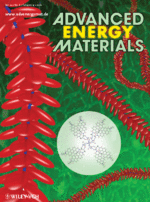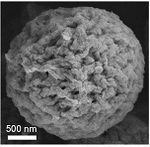New method for ordering molecules into complex patterns

Researchers at the University of Sheffield in UK and the Martin Luther University in Halle, Germany, have discovered a new way of making small molecules self-assemble into complex nanopatterns, which will push the limits of what is possible in ‘bottom-up’ methods of nanopatterning for advanced functional materials through molecular self-assembly.
The research, which was led by Professors Goran Ungar and Carsten Tschierske, is published in Science on 11 March 2011.
The study opens the way to new methods of producing ‘bottom-up’ ultra-small electronic and photonic integrated circuits. Such methods would mean that instead of the expensive and slow electron, ion-beam or X-ray lithography, the molecules would assemble and form the desired patterns themselves. Today visible or UV light is still used, but how small a pattern can be made is limited by the wavelength of light, that is of the order of a micron. Solid-state materials, particularly those performing useful functions, often have their atoms and molecules arranged in rigid frameworks whose shapes are determined by the fixed lengths and angles of the strong chemical bonds that tolerate little change. In contrast, in soft materials such as liquid crystals, the shapes of the frameworks are more easily adjustable. Self-assembling liquid crystals molecules usually contain two incompatible parts that try to keep away from each other, while being chemically bonded. As a result, such materials form a limited range of closed or open-cell structures. This research demonstrates how increasing the number of carefully selected linked incompatible groups substantially broadens the range of cellular patterns.
Some of the nanopatterns presented by the teams are the most complex in liquid crystals so far. The findings show how the molecules have formed liquid crystal honeycomb shapes with highly complex tiling patterns with cells of up to five different compositions or ‘colours’ and four different polygonal shapes. The patterns have been formed by the molecules themselves finding the optimum stacking mode through countless trials and errors. However, a good understanding of the principles of self-assembly, gained by research such as this, allows chemists to design molecules that would assemble precisely in the way they want.
The research also vividly illustrates the universality of physical principles, as it demonstrates how the same rules govern the structure, properties and phase transitions in such diverse systems as hard magnets and soft liquid crystals. In magnets it is the magnetic moments of the electrons that flip, whereas in these liquid crystals the whole molecules turn around their axes. In the magnets the interactions are between magnetic fields, whereas in the liquid crystal it is the lack of miscibility between different molecular parts that is crucial, similar to the immiscibility between oil and
water.
The researchers said: “These findings are a new step toward making molecules that will create complex molecular electronic and photonic devices spontaneously and en masse.”
Macromolecular Scaffolding for Nanoscale Architectures

New results from SUPRAMATES published in Advanced Energy Materials show that by using specifically designed molecules in a form of a rigid backbone with surrounding side chains, it is possible to control the 2D self-assembly on surfaces over a length scale of hundreds of nanometres. The resulting supramolecular structure has a rigid core and flexible linkers that allow the attached chromophores to remain close to the central chain and at the same time orientate themselves to maximise their interactions. The aromatic chromophores are used to functionalize the structure and obtain optically and electronically active architectures from which solar cells and field effect transistors can be fabricated. Read more...
Columns of Helicene

Professor Goran Ungar from the University of Sheffield and project leader of SCALES, together with collaborators from the University of Windsor (Canada), CUNY and Columbia University in New York, revealed the structure of columnar liquid-crystalline phases of helicenes. These molecules assemble to form highly complex structures arranged around a hollow core. For this study, a combination of X-ray scattering, electron density reconstruction, molecular dynamics and scattering pattern simulation techniques has been used. Results are published in Angewandte Chemie 48, 7837 (2009) and open prospects for the realization of chiral porous materials. Read more...
2D string networks based on coordination assembly

In a recent paper published in Nature Materials, FunSMARTs scientists investigate the formation of self-assembled string networks formed by an amorphous material deposited on a metal surface. The study of interactions at the molecular level in amorphous materials and glasses by traditional techniques only allows revealing averaged properties. In this work, scanning tunnelling microscopy is used to study local ordering characteristics by high-resolution imaging of the individual constituents.
The formation of supramolecular structures is induced by co-deposition of cobalt atoms which creates nodal coordination motifs resulting in the formation of strings and bifurcations. In particular, three- and fourfold nodes are observed and attributed to different chiral configurations. By specifically tailoring the coordination interactions between the ligands and the cobalt atoms, an improved stability at room temperature is also achieved. Read more...
Control of phase separation at the local level in bulk heterojunction solar cell materials

SUPRAMATES report on the synthesis of a new fluorinated compound derived from perylene bis(dicarboximide) which acts as an electron acceptor and, in conjunction with previously investigated electron donor (HBC-C12) , can be used in bulk heterojunction solar cells. The blending of these two compounds results in a formation of dimers and a phase separation on the local scale confirmed by X-ray studies. In addition, optical and atomic force characterizations carried out on samples deposited on SiOx show that the mixture does not show macroscopic phase segregation.
These results offer a new strategy to control phase separation at different scales in electron acceptor-donor blends and appeared on a cover page of the Journal of Materials Chemistry.
New technique for nanopatterning of organic semiconductors

Researcher from SUPRAMATES lead by Franco Cacialli report on a new nanopattening technique capable of defining luminescent features below 30 nm in an organic semiconductor. A thin wire mounted on an atomic force microscope is heated and scanned on surface of a widely used organic semicondutor PPV. In the contact area between the wire and the surface a local chamical modification is induced. This approach is very promising for patterning of a large variety of thermally active materials including commercial cross-linker additives and photoresist.
A press release about this work was issued by the London Centre for Nanotechnology and the article apperared in Nature Nanotechology.
SONS II session at ICAM



SONS II participated to this year's International Conference on Advanced Materials held in Rio de Janeiro (Brazil) from the 20-25 September 2009. The eleventh edition of this international conference organized by the International Union of Materials Research Societies (IUMRS) hosted about 1500 participants from all over the world and featured 28 parallel symposia covering topics in materials for nanotechnology, health, energy, environment; functional, electronic and structural materials; theory and phenomena as well as topics of general interest including education and theoretical and experimental approaches to materials engineering.
The symposium T on “Functional Materials For Organic Electronic and Nanotechnology” organized by Paolo Samori project leader from SUPRAMATES provided the opportunity to all seven SONS II collaborative research projects to present and discuss the results of their work at one of the symposia which attracted the largest number of attendees. Invited talks were given by Franco Cacialli (SUPRAMATES), Mario Ruben (FunSMARTs II), Mukundan Thelakkat (SOHYD), Ewa Gorecka (LC-NANOP) Helmut Schlaad (BIOSONS), Jan Honolka (SANMAG), and Martin Bates (SCALES).
For more information please visit the ICAM website.
Pictures courtesy of E. Gorecka (middle) and H. Schlaad (bottom)

